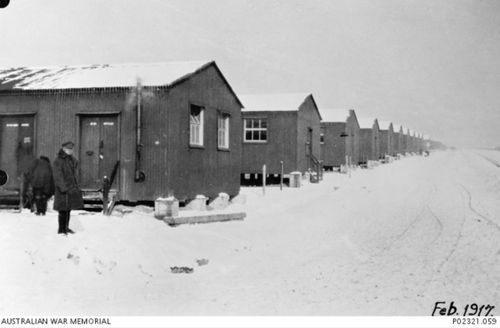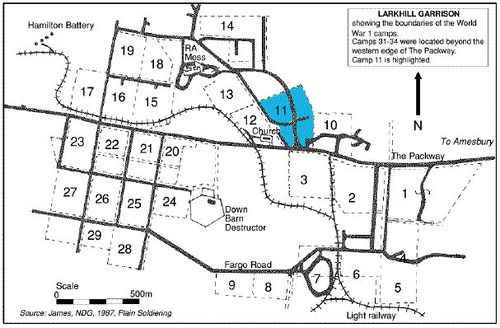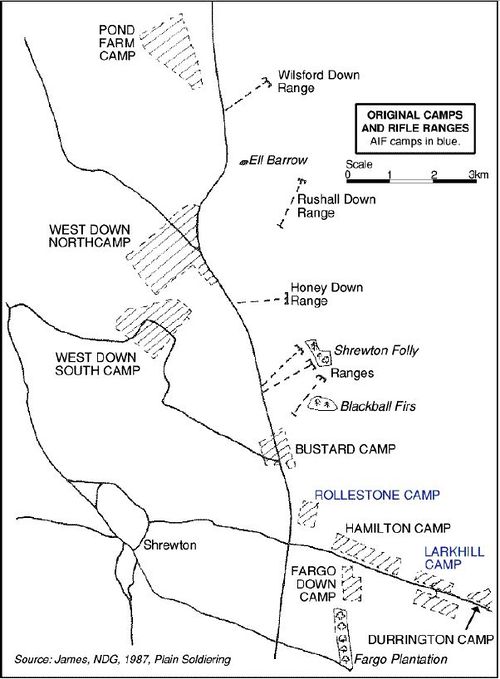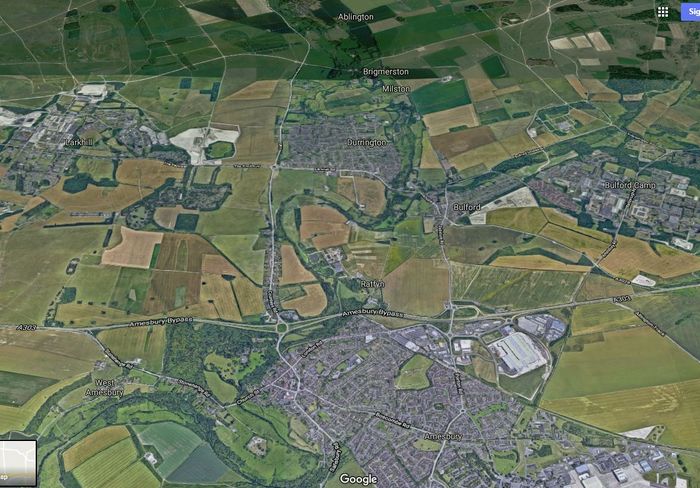Larkhill
From Our Contribution
 Main Larkhill camp buildings | |
 Area shaded blue was used by 42nd Battalion 1st AIF | |
 Location of Rollestone, Fargo, Durrington and Larkhill camps. | |
Remarks
Prewar the site was used in the summer for tented camps, but was one of the first such sites to be built on when hostilities commenced. Larkhill Camp began on 12 August 1914, and completed in early 1915, was designated as the School of Instruction for Royal Horse and Field Artillery (Larkhill). Today Larkhill Camp is a School of Artillery for the British army.
The surrounding area supported thirty four individual infantry training camps, of a size suitable for a battalion at war strength, were added, and experienced by ‘units of practically every arm of the British Army.’ Up to 20,000 soldiers were in camp at times. Larkhill received large contingents of soldiers from Australia and Canada for training before being sent to France.
A Military Light Railway connected Larkhill to the London and South-western Railway spur, at Amesbury Station, crossed the Packway and terminated at Rolleston Camp, with a spur to the site of the original Fargo ammunition dump. The course of the light railway’s permanent way, though pulled up in 1935, can be traced by a line of apple trees that, it is said, have grown from the seeds of apples thrown out by troops on passing trains.
An article in the Sydney Morning Herald on 3 Jan 1917 gives an insight into the condition of the camps on the Salisbury Plain.
Lark Hill, where the majority of Australians in England are encamped, has only recently sprung into existence, and all its buildings consist of tin huts. The officers here, including colonels and brigadiers, live in huts, though built differently, of course, from those occupied by the men. Each hut has sufficient space for 30 men, and included in its furniture is a stove, which does fine work during the cold weather. The huts are built in rows, and between each row runs a well-made street. The main camp is divided into smaller or sub-camps, these being occupied generally by a brigade, or its equivalent. Each battalion is furnished with a wet and a dry canteen, which are kept closed during parade hours. I am a bit puzzled yet to know how these canteens are run. They appear to be distinct altogether from any Australian military authority,
and appear to be semi-private affairs, which sell according to rates laid down by British military powers. They all do a wonderful trade. We are paid fortnightly, and for a few days after the great event these canteens are very busy places indeed.
Lark Hill camp is well supplied with business establishments. The Y.M.C.A. run four or five large canteens, and at night time these places are as busy as any of the Sydney tea rooms . Hundreds of pounds per week must be taken at each of these Y.M.C.A. huts . The Salvation Army canteens are very popular among the boys, and nowhere else at Lark Hill can a more satisfactory and reasonable meal be obtained. There are many business places situated on the main road, which runs through the centre of the camp. At one or the other of these places you can purchase almost any article, paying very often substantial prices. The Tommies complain that since the advent of colonials to these camps prices have increased enormously. They assert that we pay too willingly just what is asked, and I believe there is truth in this contention. At any rate, I can say without any doubt at all that many of these places are making quick fortunes.
There is no doubt about the harvest the picture palaces are reaping. The buildings are as large as our suburban palaces, and each night finds crowded houses. Some of them run two distinct houses each night. The majority of the seats cost sevenpence to occupy, there are a few at the back at fourpence, while for those in front a charge of one shilling and twopence is made. The pictures as a rule are very poor, some of those produced I saw screened in Australia long before the war commenced. They sandwich a
few vaudeville turns in between the pictures, and some of these acts are very fair, at other times they are just turns. [1]
During its training as part of the 3rd Division, the 42nd Battalion was housed in camp No 11. Some individual records mention it as Durrington camp. The Third Training Group, comprising the 9th, 19th and 11th Training Battalions was formed at Hamilton on 31 Aug 1916 before moving to Codford on 2 Oct 1916, then to Larkhill on 15 Dec 1916, and Durrington on 30 Jul 1917. Last stop was Fovant from 12 Oct 1917 until it was disbanded on 8 Nov 1917.
Soldiers who passed this way
1916
- Thomas Henry William Denny 27 Jul - 25 Nov 1916 - 44th Battalion
- Arthur Leworthy Bettenay 3 - 19 Dec 1916 - 11th Training Battalion
- Wilfred George Bettenay 3 - 19 Dec 1916 - 11th Training Battalion
- Walter Eugene Cockram 13 Dec 1916 - 3 Feb 1917 - 11th Training Battalion
1917
- William Atkins 11 Jan - 15 Jul 1917 - 11th Training Battalion
- Beverley Loxton Bennett 11 Jan - 23 Jul 1917 - 12th Training Battalion (left for overseas from Durrington)
- Henry Ogilvie Allom (Jnr) 18 Apr - 19 Aug 1917 - 11th Training Battalion (left for overseas from Durrington)
- Clarence William Hammond 26 Aug - 4 Nov 1917 - 11th Training Battalion
